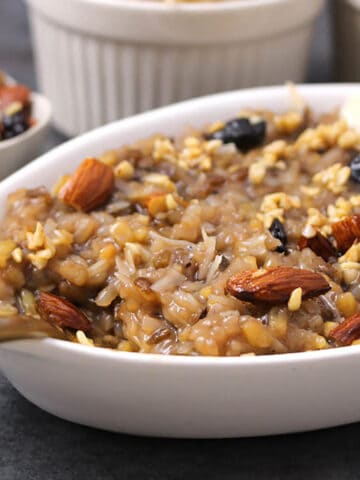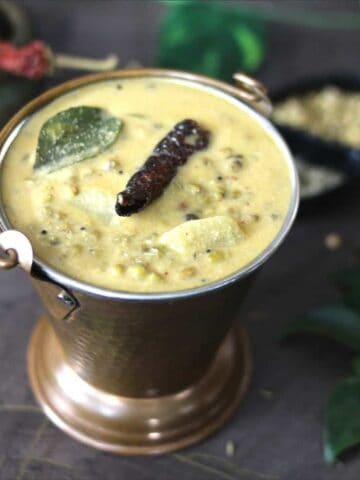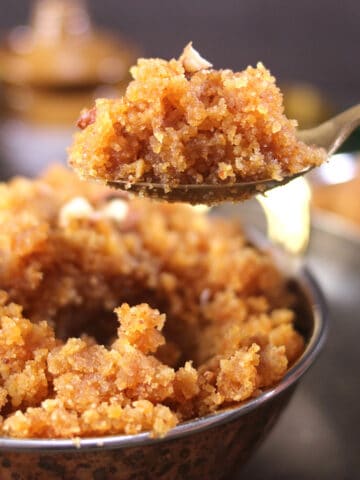You can check the list of traditional and popular Indian kheer and payasam.
Paruppu Payasam with Sabudana
Moong dal is popularly known as yellow lentils in English, mooga dali in Konkani, hesaru bele in Kannada, and Paruppu or Parippu in South Indian languages. Kheer is known as payasam, pradhaman or pudding. No Indian festival or auspicious occasion is incomplete without any one variety of kheer or payasam. Among lentils, I love payasam prepared with moong dal and chana dal using jaggery as a sweetener. Do try this for Onam, Navratri, diwali, or any festival. Also, check out classic Indian sweet dessert recipes, Diwali sweets and 9 days of Navratri recipes.
Ingredients
Moong dal: yellow lentil (hesaru bele, paippu). Check out the indian dal list to get a clear idea. Sabudana: Sago or tapioca pearls. It’s optional but gives a good texture. Jaggery: Sweetener used to make south Indian style payasam. Milk: Whole milk or coconut milk can be used. Cardamon powder: for flavor. Other ingredients: Ghee and nuts for additional flavor and crunch. Check out the recipe card for the full list of the ingredients.
How to make moong dal sabudana kheer?
To make this moong dal sabudana kheer, I have divided the procedure into 3 parts.
To prevent the jaggery from curdling the payasam, I first prepare the jaggery syrup and allow it to cool completely before adding it to the kheer. In a pan on medium heat, add the jaggery along with some water and cook until the jaggery melts completely and comes to a simmer. The best part about making kheer is that you don’t have to wait for any syrup consistency (i.e., 1-string, 2-string, etc.). Soak sabudana in water for at least 30 minutes to 2 hours. This will reduce the time of cooking. Cook sabudana till it turns translucent, stirring it occasionally. Moong dal is sauteed until aromatic and then cooked to give the kheer a different flavor.
Step-by-step instructions
Wash sabudana and then soak it in water for at least 2 hours. Meanwhile, add moong dal to a pressure cooker and roast it on medium-low flame until aromatic. Wash the roasted dal, add 2 cups of water, and pressure cook for two whistles. Add jaggery and ½ cup of water to another pan and cook until jaggery melts and syrup is formed. Let this cool completely. In another pan, add the soaked and rinsed sabudana, 2 cups of water, and a tablespoon of ghee, and cook. Occasionally, keep stirring and cook until the sabudana becomes translucent and soft when pressed between fingers. Once the pressure releases naturally, open the pressure cooker and whisk the moong dal nicely. To this, add cooked sabudana and mix.
Add milk and bring to a boil, stirring continuously to prevent it from burning at the bottom. Add crushed cardamom pods, mix well, and switch off the flame. Cover and set aside for 10 minutes. After 10 minutes, add the jaggery syrup to the kheer mixture and mix continuously. Once the syrup is added, you can serve it warm as it is. If you like to eat piping hot kheer, then reheat and serve. Add ghee to a small pan on medium heat. Add cashews. Once they turn golden, add raisins and switch off the flame. Add them to the kheer. Serve and enjoy.
Tips
You can substitute milk with coconut milk to make this kheer vegan, Kerala style, or Konkani style. If you use coconut milk in the recipe, you can add jaggery syrup along with it. If you use dairy milk in the recipe (e.g., cow’s milk), you will have to add the jaggery syrup after the kheer mixture has rested for 10 mins—this helps prevent the jaggery syrup from curdling the milk. I generally add sabudana, semolina, or rice to make the kheer or payasam thick and give a nice texture. It is optional. If you skip sabudana, then add 1 cup of mong dal to the recipe. Use 1 ½ cups jaggery for kheer with medium sweetness or 2 cups for a sweet kheer. Add any combination of nuts and dry fruits to garnish the kheer.
More moong dal recipes
Recipe card
Did you like this recipe? Please leave a star ⭐️⭐️⭐️⭐️⭐️ rating below and/or a review in the comments section. You can also stay in touch with us through social media by following us on Pinterest, Facebook, Instagram, and Twitter.










